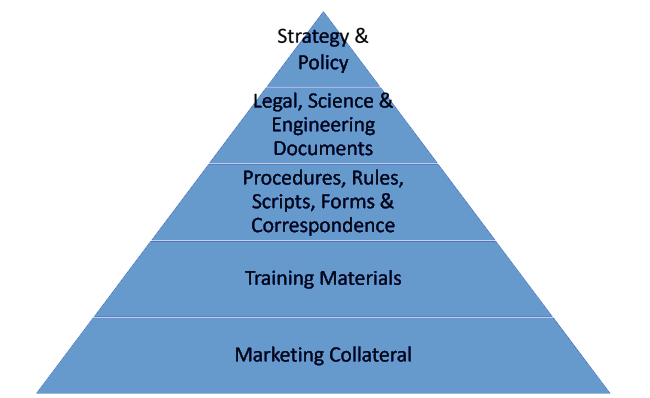Rethinking Your Business Messaging Space: Knowledge Alignment
We recently coordinated the development of an enterprise-wide concept model — think structured business glossary — for a large sovereign wealth fund. It included over 1,700 business terms and definitions, along with 65 graphic diagrams ('neighborhoods') showing visually how the underlying concepts relate. The fund's motivation? The creation of a sophisticated (and expensive) new data lake for the business. They understood clearly that without a common business vocabulary, an integrated and useful solution would elude them.
The project shone a spotlight on where a business vocabulary actually originates in the organization and who needs to be involved in its standardization. It also sharpened the necessary distinction between vocabulary vs. data ownership.
After feeling our way forward, we zeroed in on the organization's policy documents, which had official glossaries. What better place to go for authoritative vocabulary? Of course, each document had its own glossary, and none took a completely enterprise view, but those were problems they could recognize and address.
What better starting point for terms and definitions than business policy documents?! When you work on vocabulary from a truly top-down, business point of view, you see how ineffective an IT-up or data-out approach will likely prove.
The Formal Business Messaging Pyramid
Policy documents lie at the apex of different forms of formal messaging or communication in the business. The Formal Business Messaging Space in your organization takes the form of a pyramid, as illustrated in Figure 1. Business vocabulary and natural language is a central component of each layer. You find that words and sentences (roughly 'messages') are literally everywhere.

Figure 1. The Formal Business Messaging Space
Think how dis-integrated this pyramid is in most organizations. Where is any knowledge blueprint to work by?
We've been saying for years that data is central to your organization. But formal messages are even more basic. Before words can properly label your data, those words must play a central role in command, execution, and knowledge transfer. The point is so obvious, we often take it for granted.
And that's becoming the source of great pain for many organizations. As an IT professional or business analyst, you may think this 'business-side' stuff is not your concern. You're wrong. The result of such thinking is data and systems that don't 'message' effectively, ones that never seem really plugged into business knowledge.
Knowledge Alignment
A central challenge up and down the Formal Business Messaging Pyramid is alignment, which needs to be coordinated in two main ways. The first is obvious. The second, less so.
- First and foremost is strategy alignment. Messaging that is misaligned with strategy and policy will always be counterproductive. But of course, we've known that for years (even if not always practiced).
- Second, and not far behind, is knowledge alignment. Except perhaps in the limited sense of knowledge retention, the need for a deliberate, engineered focus on this kind of alignment is new.
What is the basis for knowledge alignment in the organization? Words and sentences (and ultimately labels for data). A fundamental principle for the Formal Business Message Space is that all forms of messaging should be based on and coordinated with the prime knowledge sources in the business — those of the second highest tier in the pyramid (legal, science and engineering documents).
About Requirements
You've probably noticed that requirements are missing in the pyramid. Aren't they 'messaging' too?
Yes, but requirements lie in a different dimension. They are specifications for something that needs to be built, not messaging between and among business players for directing and operating the day-to-day business.
A major failing of most requirements approach is that they are not plugged directly into prime business knowledge sources. For example:
- Many requirement documents don't even bother with a business glossary. Even when they do, it's not coordinated with the authoritative knowledge sources.
- A great many business analysts still know little or nothing about the how-to of interpreting (and questioning) policy and knowledge sources — even though this activity should be central to dialog about requirements with business stakeholders.
Does this know-how exist? Yes, we've been developing, practicing, and teaching it for years.[1]
What About Informal Messaging?
The Formal Business Messaging Pyramid focuses on formal messaging (documents of all kinds), not informal messaging such as face-to-face conversations, virtual meetings, emails, etc.
Aren't informal communications important? Of course, but let's look at the bigger picture. Going forward, what percentage of the total messaging in a knowledge-rich, digitally-oriented organization can be informal? We're already swamped. Even if we can maintain the status quo in the increasingly digital world, we're swimming against the tide. And it's only going to get worse over time.
We're quite aware that this new holistic view of the messaging-based organization needs to reach and penetrate the business side. The larger solution is only indirectly an IT or business analyst problem. But who are the agents of real change in organizations these days? If you're reading this article, it's probably you!
References
[1] The BRSolutions Professional Training Suite: https://brs1on1.com/order/
Take a 10-minute pinpoint assessment to determine whether this training could be helpful for you and your company: https://brs1on1.com/
# # #
About our Contributor:
Online Interactive Training Series
In response to a great many requests, Business Rule Solutions now offers at-a-distance learning options. No travel, no backlogs, no hassles. Same great instructors, but with schedules, content and pricing designed to meet the special needs of busy professionals.










How to Define Business Terms in Plain English: A Primer
How to Use DecisionSpeak™ and Question Charts (Q-Charts™)
Decision Tables - A Primer: How to Use TableSpeak™
Tabulation of Lists in RuleSpeak®: A Primer - Using "The Following" Clause
Business Agility Manifesto
Business Rules Manifesto
Business Motivation Model
Decision Vocabulary
[Download]
[Download]
Semantics of Business Vocabulary and Business Rules